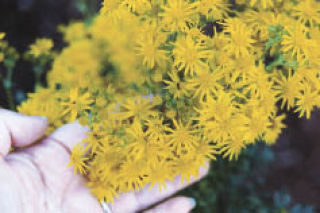Now is the time for Islanders to be on the lookout for the noxious weed tansy ragwort. This is a persistent pasture and roadside weed that was introduced from Europe and Western Asia and is now unfortunately well-established on Vashon.
You probably have seen the plant’s bright yellow flower heads in fields and along some roadsides. To the untrained eye, these sunny plants may look like lovely wildflowers. But in fact, tansy ragwort is so toxic to livestock that in large amounts it can prove fatal to a horse or cow. And even small doses can accumulate in an animal’s liver tissues over time, poisoning horses, cattle, goats, pets and even people.
August is a critical time in King County’s efforts to eradicate tansy ragwort, classified in the state as a noxious weed, because the plant is flowering but has not yet gone to seed. And its seed is pernicious: On average, a plant produces 60,000 to 70,000 seeds and as many as 200,000, which can linger in the soil for up to 15 years.
Sometimes confused with the common (and non-toxic) tansy, tansy ragwort is easy to identify this time of year. Its leaves are dark green on top and whitish green underneath with a ruffled ragged appearance. The flowers are daisy-like, with yellow petals. This easily distinguishes it from common tansy, which has button-like flowers with no petals. The flower clusters develop on stout, leafy elongated stems that grow up to six feet tall.
Tansy ragwort’s toxicity stems from its foliage, which contains pyrrolizidine alkaloids, a compound that is toxic not only when the plant is alive but also when it is dried and mixed with hay or silage. When consumed, the plant’s chemical compounds can lead to photosensitization, jaundice and wasting. Tansy ragwort also out-competes pasture and desirable native plants.
So how do Islanders begin the careful work of eradicating tansy ragwort from their land?
First, remember that now is the time to go after it, before it goes to seed. Careful, assiduous plant elimination will eventually deplete the seed-bank in the soil and, over time, put an end to infestations. Seeds are spread by wind, water, animals, farm equipment and in agricultural produce, including hay. Take care not to introduce seeds into clean areas.
When controlling tansy ragwort, it is best to focus on lightly infested areas and work towards areas of higher infestation.
Manual removal works well, especially for lighter infestations and in moist soils. The key here is to remove the entire root, as the plant can re-grow from root fragments. Hand-pulling often leaves roots behind, and mowing will also not eradicate the weed as the roots are unaffected. Using a hoe, mattock or shovel is usually more effective. It is best to cut and bag flowerheads to eliminate seed production. Pulled flowering plants can still set seed.
Tillage can work for large areas when combined with an improved pasture or cropping program, but this may initially expose more seeds for germination. Chemical control — with a low-toxicity herbicide registered for such use — may help control large infestations. Herbicide applications for tansy control are best done in the spring before flowering.
Try to maintain a dense competitive vegetative cover, such as pasture or native vegetation. This will greatly reduce seedling re-establishment and out-compete new weeds that try to emerge.
Because tansy ragwort’s seeds are so long-lived in the soil, follow-up control will be needed for more than one season. Check for small plants at the rosette stage every spring and remove any found.
It’s also a great idea to coordinate your control efforts with those of your neighbors so that larger areas are controlled at the same time.
Many Island landowners have shown that with a little persistence and effort, tansy ragwort can be controlled. Indeed, some remember 30 or 40 years ago, when Vashon’s tansy problem was far worse than it is today.
— Steven J. Burke is manager of the King County Noxious Weed Program.


